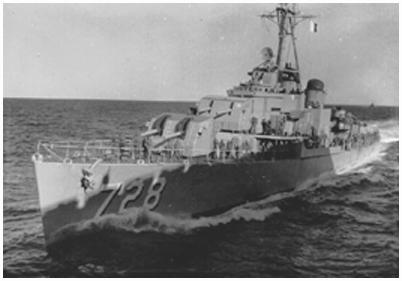 |
 For the Official U.S. Navy "Welcome Aboard" go here. |
 |
 For the Official U.S. Navy "Welcome Aboard" go here. |
|
DD-728:
Displacement - 2,200 Length - 376' 6" Beam - 40' 10" Dr.- 15' 8" Speed - 34.2kt Compliment - 345 Armaments: 6 - 5" .38's [ More Info ] 12 - 40mm [ More Info ] 10 - 21" tt [ More Info ] Class: Allen M. Sumner |
 |
The destroyer was named in honor of Sergeant Duncan Mansfield, a United States Marine. According to the Marine Corps Historical Center, Mansfield was born at Albany, N.Y. The date of his original enlistment (3 years) 11 August 1798; place of enlistment Philadelphia, PA. Age at time of enlistment, 25 years and 7 months. He was discharged 29 July 1801 and re-enlisted (3 years) 30 July 1801 and finally discharged, 2 April 1805. He entered on board the U.S. Schooner ENTERPRIZE as a Sergeant on April 5, 1803. He was transferred to the U.S. Frigate JOHN ADAMS on September 20, 1804. He was returned to the United States in the JOHN ADAMS and detached March 24, 1805. While serving on the schooner ENTERPRIZE during the war with Tripoli in 1804, Sgt. Mansfield volunteered for an expedition led by Lt. Stephen Decatur, Jr. On February 16, Decatur and his 84-man crew sailed the captured Tripolitan ketch, renamed INTREPID, disguised as an Arabian ship, into Tripoli Harbor to destroy the captured U.S. frigate PHILADELPHIA to prevent her use against the United States. Lord Nelson called the action, "the most bold and daring act of the age."
After completion of her shake-down cruise off Bermuda, MANSFIELD steamed via the Panama Canal, to the west coast arriving in San Diego, 10 September 1944. A week later in company with Destroyer Division-122, she headed for Pearl Harbor, conducting intensive training en route. After further training exercised at Pearl Harbor, MANSFIELD and four other destroyers escorted a convoy to Ulithi Atoll; a 19-mile long, 10-mile wide, crescent-shaped coral island, in the West Caroline Islands of the Western Pacific, six thousand miles from San Diego - their base for the next six months. Some other memories not posted are: These are some of my memories and I will admit that memories can indeed be
misleading." - C W Mc Queen WT 1/c 1944-45 Ulithi, captured from the Japanese on 23 September, was wanted and used for its big and deep lagoon. It was the strategic advanced fleet base for Task Force 38 and 58 - the Navy's main striking arm: the Fast Carrier Forces Pacific Fleet. Ulithi, was said to be the best anchorage in its part of the Pacific and could shelter a thousand ships in its vast lagoon.
Under a dual fleet command setup, the Third Fleet Shared the same naval force with the Fifth Fleet. While one fleet commander and his staff were at sea operating against the Japanese, the other commander and staff would be ashore at Pearl Harbor planning the next operation. Admiral William F. Halsey commanded the Third Fleet from June 1944 until November 1945. Commanding the Fifth Fleet from March 1944 until May 1945, was Admiral Chester W. Nimitz, commander-in-chief of the Pacific Fleet.
Vice Admiral Mark A. Mitschner, commanded Task Force 38 - the Fast Carrier Force: the Enterprise and eight Essex class carriers, eight Independence class light carriers, with an ample screen of two new battleships, three cruisers and 14-destroyers.
A Task Force is organized for a specific type of operation and their designation is based on fleet assignments: thus Task force 38 and 58, was the carrier striking force of the Third or Fifth Fleet, with subordinate Task Groups designated as 30.1, 38.1, 38.2 or 58.1, etc.
Upon arrival at Ulithi, MANSFIELD joined Task Group 38.1 (commanded by Vice Admiral John S. McCain) to screen for the carriers and served as a picket during air strikes against central Luzon, including the Manila area of the Philippines. On 10 December 1944, MANSFIELD, with Destroyer Squadron-61 in task Group 38.2 (commanded by Read Admiral Gerald F. Bogan) screened for carrier raids on Luzon, in support of the Leyte invasion. After several successful strikes, and the horrors of a sudden typhoon which generated waves 50 to 60 feet high, capsizing destroyers Hull, Spence, and Monaghan; MANSFIELD's task group picked up survivors and returned to Ulithi. Halsey's fleet suffered significant damage from the typhoon, and his failure to take proper precautions was regarded as the principal reason, although he was only mildly reprimanded. A similar lapse during a June 1945 typhoon was less favorably viewed and he was nearly relieved of command.
MANSFIELD joined Task Group 30.1 on 30 December, and screened for carrier air strikes against Formosa and central Luzon. Afterwards, Halsey took the Third Fleet with Task Group 30.1, through the Bashi Strait into the South China Sea until 20 January 1945. No Japanese units challenged Halsey's fleet during its 3,800 mile foray which spewed destruction on Formosa, Luzon, and Japanese shipping along the Vietnamese and China coast from Hong Kong to Saigon. The Third Fleet battered enemy facilities and merchant ships and destroyed 112 Japanese planes.
In February 1945, three days prior to Iwo Jima D-day, MANSFIELD screened with the Fifth Fleet in Task Group 58.1 (commanded by Rear Admiral Joseph J. Clark) as carrier air strikes were launched against targets over and around Tokyo. The raids were conducted not only as a shield for Iwo Jima, but to destroy enemy planes and reduce the Japanese capability for launching air attacks. From 17 to 23 February, she screened in Task Group 58.1 during carrier attacks for the Iwo Jima assault, and then steamed at full speed back to the Tokyo area for bombing runs on Nagoya and Koybe. Heavy weather set in, and the task group retired southward, blasting enemy shore installations on Okinawa while en route to Ulithi for replenishment.
From 14 March to 27 April 1945, MANSFIELD screened for carrier strikes against southern Kyushu, followed by sweeps against Okinawa Gunto. On 9 May 1945, the carriers again pounded Kyushu, Okinawa, and the island groups in between. Mitschner's carriers while supporting the Iwo Jima and Okinawa landings, and raids on Japan and Formosa, suffered heavily from Kamikaze attacks.
Okinawa in April, May and June was worse for the Navy, "the most costly naval operation in naval history," according to the historian Elmer B. Potter. The Fifth Fleet lost 34 vessels sunk and 368 damaged, many irreparably. About five thousand sailors died, and almost that number wounded, many grotesquely burned. In May, Mitschner had to shift his flag twice; from the carrier Bunker Hill, to the Enterprise, to the Randolph, as each carrier was seriously damaged. Toward the end of May, Nimitz relieved Spruance and Mitschner who were stressed almost beyond endurance by remaining continuously on station at the two invasions.
From 28 May, when Halsey came back the Fifth Fleet became Third Fleet once again, and Task Group 58.1 became Task Group 38.1. It began to rove along Japanese waters as soon as Okinawa was "secured" on 21 June. Admiral John S. McCain now commanding Task Force 38 raided Tokyo and other targets along the Japanese coast with impunity. On 17 July, Halsey's 105 ship armada hit the large naval base at Yokosuka, outside of Tokyo. Three weeks before V-J Day, MANSFIELD with eight destroyers of Destroyer Squadron-61, conducted a daring high-speed torpedo run into Nojima Saki, sinking or damaging four enemy ships.
On 27 August 1945, assisted by another destroyer, the USS Blue (DD-744), the MANSFIELD captured the Japanese submarine I-400 off the coast of Honshu.
The atomic age was born on 6 August when the Air Force B-29 super fortress "Enola Gay" dropped the first atomic bomb at Hiroshima. The 20th Air Force dropped a second atomic bomb on Nagasaki on 9 August. It was all over. Nimitz ordered Halsey to "cease Fire" on 15 August.
After witnessing the formal Japanese surrender ceremony on Sunday, 2 September 1945 in Tokyo Bay, MANSFIELD returned to the west coast.
The United States Navy's mastery of the seas at the close of World War-II was without historical precedent. The war was finally over, and it was time to bring the "boys" home. Their implements of war were discarded or, in the case of hundreds of navy ships, put into "moth balls", a system of preservation and storage. A few ships launched before termination of hostilities did manage to enter the active ranks.
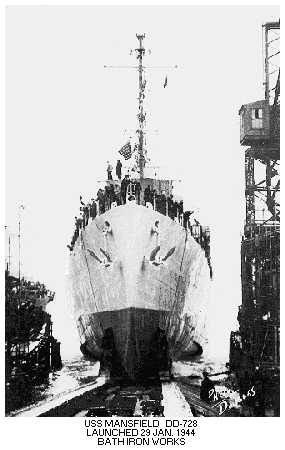 The MANSFIELD was part of America's wartime naval build-up, which saw United States Shipyards deliver some 390 destroyers to the Navy during the course of World War-II. Her Active duty spanned three wars; World War-II, Korea, and Vietnam.
The MANSFIELD was part of America's wartime naval build-up, which saw United States Shipyards deliver some 390 destroyers to the Navy during the course of World War-II. Her Active duty spanned three wars; World War-II, Korea, and Vietnam.
![]()
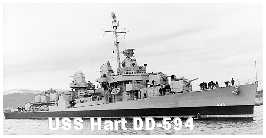 The name Mansfield was canceled for DD-594 and reassigned to DD-728 on 26 July 1943. DD-594 was renamed Hart (q.v.) on 21 March 1944 before launching.
The name Mansfield was canceled for DD-594 and reassigned to DD-728 on 26 July 1943. DD-594 was renamed Hart (q.v.) on 21 March 1944 before launching.![]()
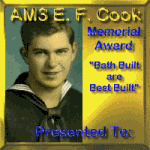 MANSFIELD (DD728) was launched 29 January 1944 at the Bath Iron Works Corp., Bath, Maine, and commissioned 14 April 1944, with Cmdr. Robert E. Brady Jr., in command.
MANSFIELD (DD728) was launched 29 January 1944 at the Bath Iron Works Corp., Bath, Maine, and commissioned 14 April 1944, with Cmdr. Robert E. Brady Jr., in command.
From shipmate C.W. McQueen [12.21.01]: "I went aboard the Mansfield in February 1944 and we took her on a shakedown cruise to Bermuda. On a high speed run we achieved 38.9 knots. This was with a clean [ new ] hull without marine growth. The ship was commissioned about mid April and immediately left for the Panama Canal. Through the Panama Canal and a one day layover in Panama, then on to San Diego and a 3 day layover. We then went on to Port Chicago for ammunition, and on to Pearl Harbor. We were there for 2 or 3 days and then left for the Western Pacific. If my memory is correct, our first action was in June and consisted of shelling an island and laying down a smoke screen in preparation for Marines to land. My memory tells me that we had several engagements prior to the posted September 1944 arrival date.
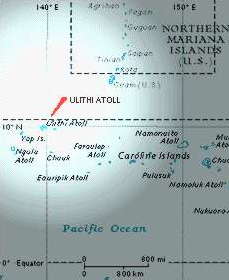
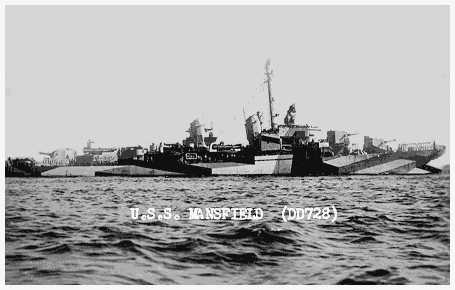
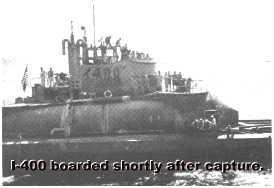
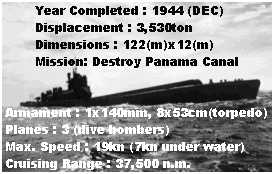
To learn more about the I-400 go here.
A new browser window will open. Please close it when done to return here.